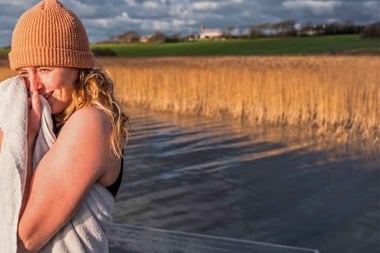An Aboriginal Approach to Fighting Cancer
Cancer is like a prairie grass fire--it often spreads quickly and consumes all in its path. Buffalo medicine teaches us that those who survive the prairie fires keep a level head, knowing where to go to stay alive..
Cancer is like a prairie grass fire it often spreads quickly and consumes all in its path. Buffalo medicine teaches us that those who survive the prairie fires keep a level head, knowing where to go to stay alive. Dealing with cancer using sacred medicines means a similar shift in thinking.
Cancer and diabetes were virtually non-existent when plant medicines were discovered. Now, modern illnesses have caused us to revisit our "plant people" to determine if traditional medicinal herbs have new uses. Cancer is one of the illnesses we have targeted, heads and horns down-to charge like buffalo!
Much of what our ancestors had to say about "purification" is correct. The old healing rituals remind us of the need to keep internal organs free of toxic build-up. Blood purification rituals are practised annually to keep the body free of viruses and parasites. Anything which suppresses the body's immune function is capable of starting one of the disease fires.
We use burdock root tincture for a month each autumn as a simple cleansing routine. Black walnut tincture has additional properties as a blood cleanser and vermifuge and is useful at any time of the year. Contemporary thinking about diet agrees with that of our ancestors' thinking: no hydrogenated fats, increased fibre and elimination of substances like refined sugar, alcohol and (from my observation) preservatives. This is a healthy start. The ancestors' diet of whole, natural foods, roots, vegetables and fruit when followed religiously, is both heart-smart and healing.
The ancestors' traditional diet included healing teas. The following is a partial list we use when dealing with the lifestyle changes associated with a diagnosis of cancer. These herbs often require special gathering and preparation.
Certain plants, like burdock, are gathered when they are first-year plants to maximize potency. Others are gathered before full blossoming, while some are gathered after maturity. In the case of plants like mayapple, if picked at the wrong time they are actually poisonous. Some plants are so specialized that even the time of day they are picked is crucial. Certain plants are gathered for the blossoms or leaves while some are gathered for the roots sometimes just certain sections of the root. We are careful of the moon quarter we harvest in, preferring new moon through full moon for this task. Occasionally, if necessary, we harvest in the third-quarter of the moon cycle, but never in the fourth quarter.
Ancestral Medicine is Best
In terms of preparation, plants might be dried and consumed in capsules while others are made into tea. Some are boiled with water and others infused in alcohol to extract their essence. This is the education of the medicine person we do not want desperate people going out and getting just any old version of the plants mentioned and trying to heal themselves. In North America, medicine people have used trial and error for tens of thousands of years to determine plant use.
- Indian pink, also known as cardinal flower (Lobelia cardinalis), and chicory/cornflower (Cichorium intybus) were used historically as a poultice for fever blisters. Currently, they are used in combination for skin cancers and radiation exposure. They can be combined with white pine blister rust to increase potency.
- Ironwood (Ostrya virginiana) bark, from the side of the tree facing the sun, is boiled and applied to rectal cancers.
- Pipsissewa (Chimaphila umbellata) is used in combination with other plants (spearmint or curly mint) as a tea for stomach cancer.
- Fleabane (Erigeron canadensis). The whole plant is gathered, just before the daisy-flower blossoms, and boiled in three litres of water. The mash created is used as a wash and poultice on cancers of the legs.
- Common thistle (Cirsium vulgare) is made into tea and consumed throughout the day.
- Wild sarsaparilla (Aralia nudicaulis) is eaten and made into teas to use as a preventive for both diabetes and cancer. It's considered a blood purifier.
- Garlic (Allium) needs to be eaten daily, both as a preventive and to combat active cancers. Don't like garlic? Take odourless garlic capsules.
- Ground ivy (Glecoma hederacea), when combined with honey and calendula marigold into a tea, helps with cancers that eat away flesh.
- Bittersweet (Solanum dulcamara) inhibits the growth of tumours and can reverse their progress.
- Bloodroot (Sanguinaria canadensis) is a multipurpose plant whose application to cancer is best derived from ingestion of the tincture.
- Celandine (Chelidonium majus). The root of this plant is used as a tincture for liver obstruction and cancer
and externally as a poultice for skin malignancies. - Yellow dock (Rumex crispus). The root is used both internally and externally for cancers that produce swellings due to wastes accumulating in the tissues. Primarily it's used as a tincture or tea.
- Witch hazel (Hamamelis virginica) is an important plant whose bark and leaves are prepared as topical poultices and from which a tincture is derived for internal consumption.
- Violets (Viola odorata) give a tea used for cancer of the throat. I find this useful for any smoking-related cancers.
- White cedar (Thuja occidentalis) is a sacred "Standing Person" (tree) to aboriginal people. A tincture from fresh green twigs is used for a variety of cancers.
- Red clover (Trifolium pratense) is a plant of the "Times of Winds and Changes." Much recited in prophecies as a plant of the millennium, it's used in combination with other plants to produce profound, rapid healing. What plants it is combined with depends on the aspect of the cancer and the individual for whom it is being prepared.
- Wild indigo (Baptisia tinctoria) has many applications, cancer being only one. The bark, root and leaves are used to create a tincture that is used alone and with Echinacea angustifolia.
- Goldenseal (Hydrastis canadensis) is virtually gone from the wild, due to extensive over-harvesting. It's an immune stimulant and cancer agent, but must be taken intermittently. It's commonly combined with echinacea to speed healing.
- Comfrey (Symphytum officinale) is another important addition to the healer's medicine basket. When combined with elecampane in a tea, it's well known to affect lung problems of all kinds, including tuberculosis and lung cancer. It affects other cancers as well.
There are many other plants, like pokeweed and chaparral, which are not as readily available in the north. Professionals must handle mayapple preparation. It's toxic if picked too early in the season.
The Ancestors' Diet
I wrote the following about the ancestors' diet: "For breakfast we consume things 'high off the earth'nuts, berries and fruits. This gives us the fructose, fats and proteins to get energized. The natural fruit sugars, or fructose, do not increase blood sugar levels in the same way as refined sugars. At lunch we eat the 'three sisters' (corn, beans and squash), grains and vegetables that grow above ground. From this group we get the complex carbohydrates, vegetable proteins and fibre needed to sustain high energy levels. For supper we eat root vegetables those grown below ground and occasionally fish, fowl or animal protein. These plants provide starches and fibre and sustain blood sugar levels through the night because they take longer to digest. Historically, animal proteins were eaten only every three or four days. This is a pH-balanced way of eating and it ensures a primarily plant-based source of protein."




